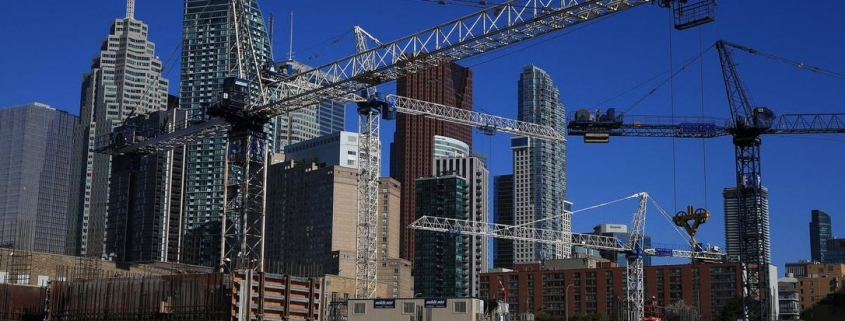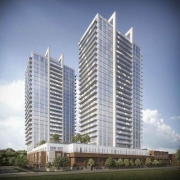Toronto’s low-income renters may soon get some relief from the city’s overheated market following the announcement of a $1.4-billion rental housing benefit co-funded and agreed on by the provincial and the federal governments.
Housing Minister Steve Clark said he expects the Canada-Ontario Housing Benefit, which eligible participants can use wherever they decide to rent, will support roughly 5,200 households provincewide during the first year of the program and that number will increase annually. He made the comments following a Thursday morning press conference announcing that Ontario would be the first province to start the rollout of the national program.
Clark said households can expect to receive on average about $575 per month, although more precise details are expected to be negotiated based on city size and needs identified by service providers. In terms of program expansion, Clark said “this is something we are going to take our time with as we roll it out.”
The minister’s office later confirmed to the Star that Toronto is expected to receive about $7.5 million over 2020 and 2021, just the start of a program expected to continue for about an additional seven years.
Mayor John Tory described the announcement as “another great example of how governments are working together” to help residents in need, in a statement released before he spoke at the conference. “Making sure people have access to affordable housing is a top priority for me as mayor and that requires the co-operation and support of other levels of government.”
The national rent program is expected to help at least 300,000 low-income renters across Canada, over seven years, as part of the National Housing Strategy, and is valued at $4 billion, once provincial and territorial cost matching is factored in. Exactly how the $1.4 billion will be divided across the province has yet to be worked out.
Priority will be given to households eligible for or on a “social housing waiting list and households in financial need living in community housing. This includes survivors of domestic violence and human trafficking, persons experiencing or at risk of homelessness, Indigenous persons, seniors and people with disabilities,” a government release states.
Asked how this will be worked out, as some cities, like Toronto, are facing higher costs than others, Clark spoke to the accepted calculation that affordable housing is about 80 per cent of what is considered average market rent and that no household should be paying more than 30 per cent of income to cover those costs.
While the National Strategy has been publicized as being worth as much as $55 billion, Ontario’s Office of the Parliamentary Budget Officer determined the actual federal dollars pledged represented a “nominal” increase in spending on housing once current spending and the winding down of existing housing programs are factored in, as outlined in a June 2019 report.
For the national benefit to work, the federal government is operating on the assumption provinces and territories will kick in their portions of the money for the length of the program, according to the report, and “it is still not clear this would require a meaningful increase in spending as, for example, social assistance payments could be reclassified as matching funding.”
The active wait-list for subsidized housing across Toronto was counted at more than 102,000 households during the first quarter of 2019. More than a third were identified as seniors, according to numbers posted on the city’s website.
Thursday’s announcement was made in front of a Toronto Community Housing building at 150 River St., near Dundas Street East, and part of the newly revitalized sections of the Regent Park neighbourhood. That building contains 125 rent-geared-to-income units and 33 units of what is defined as affordable housing and whose residents were chosen through a lottery-like system, said TCH spokesperson Bruce Malloch.
People who wanted to live in those affordable units, two- and three-bedroom apartments costing $1,194 and $1,331 respectively, submitted their names into a random draw and if selected their applications were considered.
The maximum household income for the two-bedroom units was $57,312, and $63,888 for three-bedroom units.
Malloch said more than 1,800 applications were made for the two-bedroom units and more than 1,600 applications for the three-bedroom apartments. Residents are starting to move in this week.
What constitutes affordable housing is typically based around numbers reported by the Canada Mortgage and Housing Corp., which tracks what people are paying for occupied purpose-built rental units. Condominiums are considered a separate category and are not included.
Housing is considered affordable if it matches or is lesser than the average of those occupied purpose-built rentals, which are subject to rent control. In Toronto, landlords can charge whatever they want for empty units, and any units occupied after mid-November 2018 have no rent controls at all.
Across Old Toronto, the average cost for a two-bedroom apartment in 2018 was $1,829 and a three bedroom was $2,473, according to the most recent CMHC rental market housing report for the Greater Toronto Area.
Research firm Urbanation reported that average rents for newly leased or available purpose-built rental units was about $2,515 per month, in an October news release. The release did not include unit size.
Correction — Dec. 19, 2019: The benefit is expected to help 300,000 low-income renters across Canada. A previous version of this story said the number would assist 300,000 people across Ontario.







 Maziar Moini, Broker of Record - Home Leader Realty Inc.
300 Richmond St. W., #300, Toronto, ON M5V-1X2
Maziar Moini, Broker of Record - Home Leader Realty Inc.
300 Richmond St. W., #300, Toronto, ON M5V-1X2



